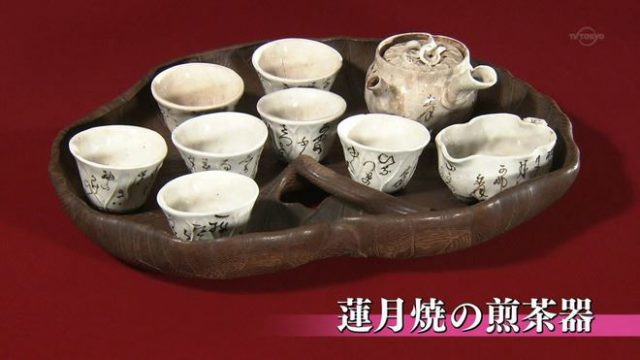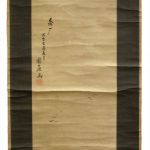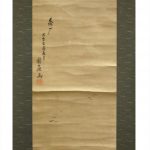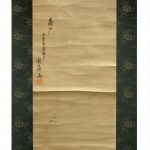Restoration Order from the U.S.A. : Rengetsu Tanzaku & Entei Kakejiku
Living a life of selflessness like Ōtagaki Rengetsu(Lotus Moon)
Meeting Tim-san for The First Time
One day, we received a message from a gentleman named Tim-san in the USA, asking us questions for remounting tanka and kakejiku. “I have a tanka mounted to kakajiku that I want mounted as tanzaku. Please send any questions and pricing. Thank you.”
Communicating with him by email had been an unforgettable experience. Words can’t describe how much fun we had. There are always some enlightening words of wisdom in his email and they touched our heart. We came to know that he is a student of the Urasenke school of Tea. He is also well versed in Japanese arts, pottery, poetry, literature, Zen spirit, and Buddhism. When it comes to a philosophy and ritual of tea, he knows way better than us.
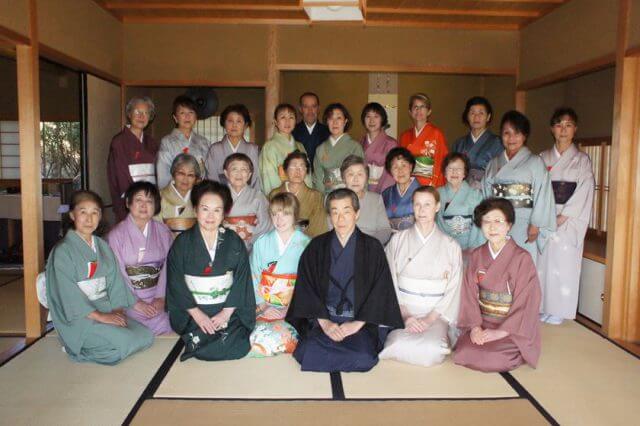
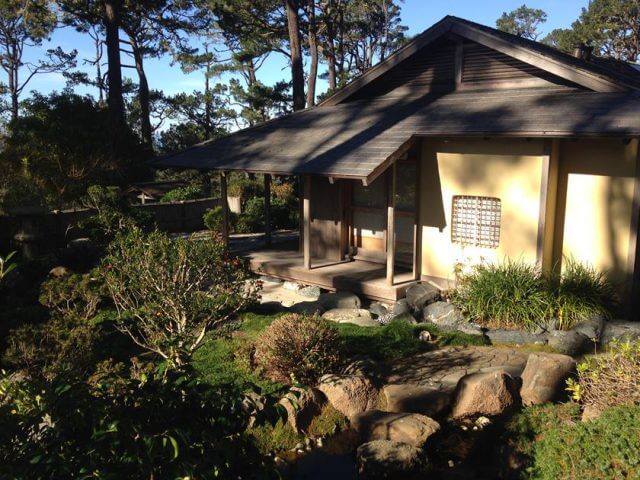
Wow. It is an amazing chasitsu/tearoom surrounded with a beautiful garden. Visiting here must be a peaceful getaway from the hustle and bustle of modern life.
Kakejiku/Kakemono as One of the Tea Utensils
The Japanese tea ceremony is called Chanoyu, Sado or Chado in Japanese. In Chanoyu, kakejiku is called kakemono and there are other utensils such as a flower container, a powdered tea container, and a tea scoop. A kakemono in a tea room’s alcove is considered very important and chosen with great care by the host. This is because it represents the main theme of the tea gathering and helps set the atmosphere with a flower arrangement. For the tea gathering, a kakemono with a calligraphy, a simple picture or both (called Gasan) is often chosen. More specifically, it often bears a calligraphy of a Zen phrase by a Zen monk in the Daitokuji-temple school of the Rinzai sect. Some well-known examples of Zen phrases are 一期一会/ichigo-ichie, 和敬清寂/wakei seijaku, 日々是好日/nichi-nichi-kore-koujitsu and 円窓/Zen circle. As the saying “茶禅一味/chazen-ichi-mi” goes, chanoyu has its origin in Zen sect of Buddhism so 茶禅一味 means the chanoyu and Zen is basically the same so Zen and chanoyu are inseparable.
Chanoyu involves architecture, the garden, calligraphy, flowers, pottery and much more. Thus, a kakemono is not only a work of art for appreciation but also for practical use as one of the tea utensils.
Chagake – a Hanging Scroll for a Tea Gathering
For a kakemono that is hung in a tearoom, sou mounting style is thought appropriate. We, mounter usually call Sou mounting style “chagake”(tea-hanging). It is a mounting style that fits the philosophy of Zen, which cherishes frugality and wabi-sabi.
For more info on Sou mounting style, refer to :
“Sou” style mounting is the mounting format used for paintings and calligraphic works written by a master of the tea ceremony, or a Zen priest. In this type of mounting, the “hashira” (the sides of the “naka-mawashi” inner enclosure) are narrower than those of the “gyou” type. Since sou style mounting avoids excess decoration, the kind of format in which “ichimonji” (two long strips of cloth put on the top and bottom of the main work) surround the work does not exist. Thus, there are two kinds of sou style mounting. This mounting format is commonly called “rinpo” mounting,” “rinhoe” mounting,” or “chagake” mounting.
Philanthropy Work
One of Tim-san’s greatest passions is getting involved in philanthropy work. For example, he told us about a pond building project for a salamander and volunteer building projects in Southeast Asia that he had participated several times before. Tim-san is among the most thoughtful people we had ever met. It seemed to us his kind heart aches for people, animals, and even nature that are in the challenging situation. Volunteers can sometimes be caught off-guard by feelings of sadness, guilt or being overwhelmed. It can be physically and emotionally draining while the work is rewarding.
In those cases, taking tea lessons (okeiko) is one of the great cures to Tim-san. There are the sublime peace and tranquility that can come from the study and performance of tea. It serves as an elixir to help you maintain the ideal state of mind. Also, tea lessons work well when life is busy. We forget to take care of ourselves and our own needs. We all need a moment to stop and breath. Tea lessons are a valuable time for Tim-san. Time to himself with a feeling of deep and peaceful harmony.
Order for remounting Tanka to Tanzaku
This is Tim-san’s tanka.
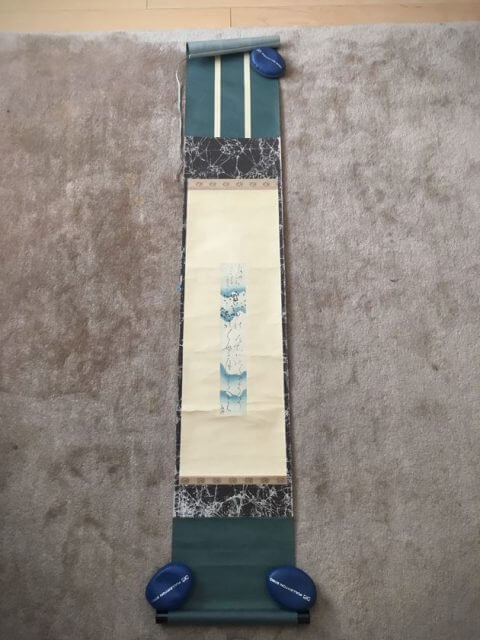
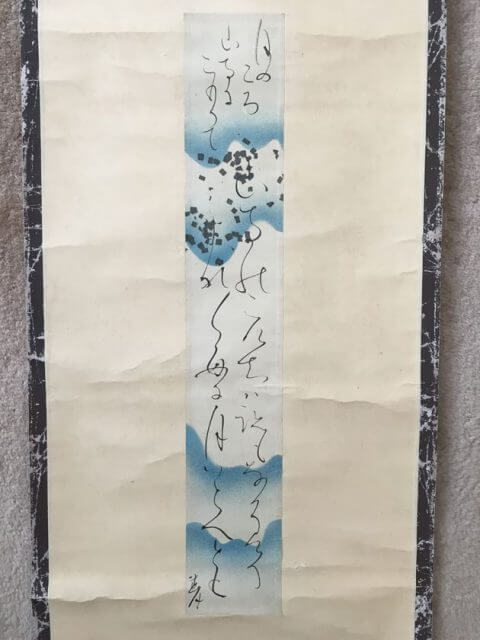
Isn’t it exquisite calligraphy? Thin and delicately made. Japanese kana characters are soft rounded and written in an easy, relaxed manner.
We are going to cut the tanka part of a kakemono first and will mount it as tanzaku. This is detailed but a simple procedure compared to remounting a hanging scroll. As we have not introduced the procedure yet, we would like to explain it in short.
Wet the tanka and remove old backing paper.
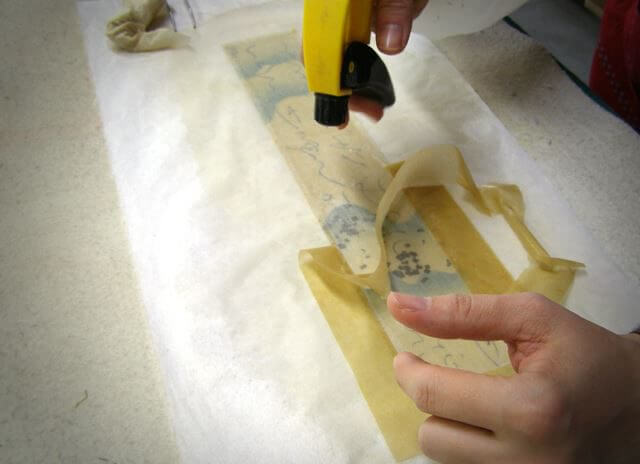
Removal of backing paper is done.
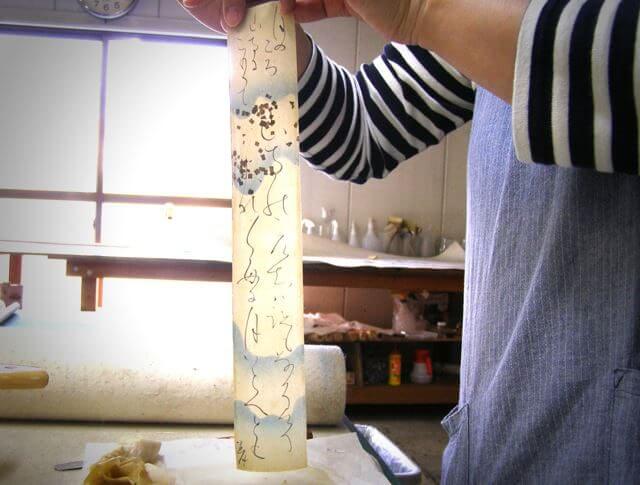
This is after we applied a backing paper. A poet’s signature, Rengetsu(蓮月) is very close to the bottom left. To save it, we left an extra margin on all sides for paste.
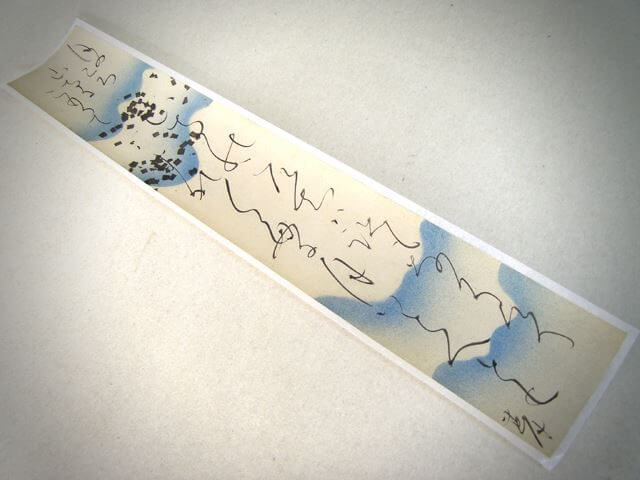
After applying the sheet of tanka to a tanzaku paperboard, we add the final touch by using thin strips of Japanese gold paper, to surround the tanzaku board.
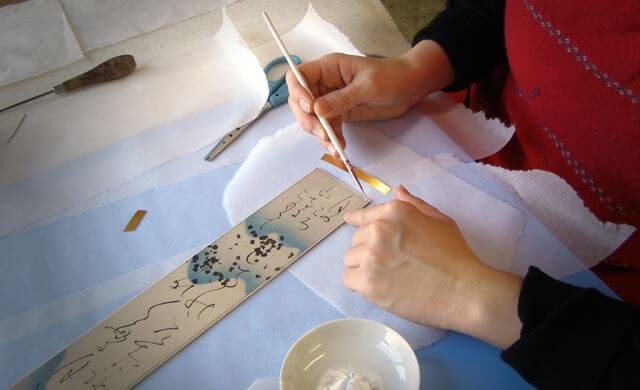
It’s complete.
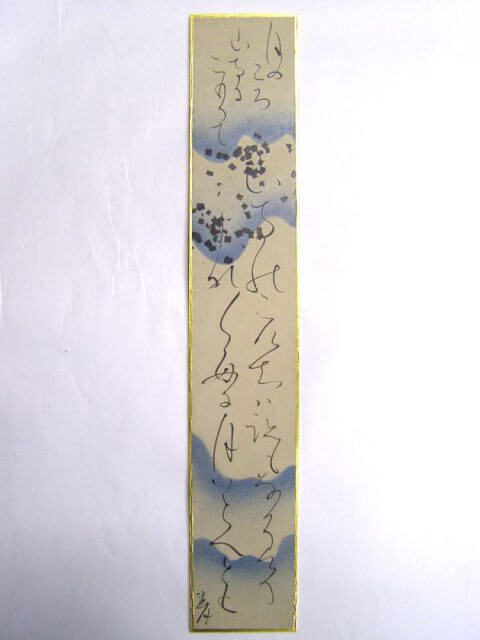
Rengetsu Tanzaku
Tim-san told us that this was a tanka by Rengetsu Otagaki. We looked up what was written here as far as possible and here is what we found;
The Original
月のころ 山寺にこもりて
山寺のこけちは跡もなかりけり
まれ〱毎に月はとへとも 蓮月
With Kanji Designated for Daily Use
月の頃 山寺に籠りて 山寺の苔路は跡もなかりけり 稀々ごとに月は訪へども 蓮月
How to read in Japanese
Tsuki no koro yamadera ni komori te
Yamadera no kokechi wa ato mo nakari keri
Maremare gotoni tsuki wa toedo mo. Rengetsu
We tried to translate this in English.
In the season when the moon appears most beautiful, I shut myself in the mountain temple
No human has ever set foot on the moss-covered path here
Though the moon visits very occasionally and upon the path shines the moonlight.
Japanese Meaning
月の眺めのよい頃、山寺に籠って 山寺の苔の生えた道は人が踏み歩いた跡もないことだ
ごくたまにこうして月が訪れ、美しく照らすけれども
As we look Rengetsu Otagaki up, we couldn’t help getting more and more interested in her. What was her personality like? Curiously enough, we found Rengetsu and Tim-san are two of a kind. They are both giving persons, they have a passionate belief in what they are doing, and they love tranquility and peace. Of course, they are at different times and places but live similar lives. As is often said, the mind is like a magnet and magnetic power of the Universe draws similar energies together. Don’t you think Rengetsu Tanzaku served as a magnet? and it has been drawn to someone who had the same mind as Rengetsu.
Now, like us, you may be interested in Rengetsu Otagaki so let us allow to share information about her.
Life of Rengetsu Otagaki
An overview of Rengetsu’s life is available on Wikipedia as below;
Here, we would like to focus mainly on her story that describes her personality and beliefs.
Although Rengetsu Ōtagaki (1791–1875. born in Kyoto) is said to be descended from the elite samurai family, the Tōdō of Tsu Domain (now known as Mie Prefecture), she became an adopted daughter of a lower-class samurai, the Ōtagaki and saw so much tragedy in turbulent times of Meiji Restoration. Rengetsu lost two husbands and all her children (the number of children varies from 4 to as many as 6, according to references). After she became a Buddhist nun, she took her Buddhist name, Rengetsu (or Lotus Moon) and dedicated her rest of life to poetry and pottery.
Being gifted with both intelligence and beauty, Rengetsu is best known for her beautiful poetry. She is also known as a potter. This is a work she first started to make a living.
Once Rengetsu’s pottery became popular, many fake potteries were on the Kyoto market. Rengetsu did not care about it all because she knew it would support people’s lives. She even went all the trouble to inscribe her waka poetry herself on these copies. She was happy when her poetry helped people sell more fake potteries. In her old letters, you will see how she felt about her pottery. Many times, she said that her potteries were busaiku/ugly or not good. It is clear she underestimated her talent and stayed humble even after her pottery became popular and sold well. After her death, the production of her copies continued, got more and more popular, and finally, a genre called “Rengetsu-yaki /Rengetsu-ware” was established.
There is one more well-known fact about Rengetsu that she lived with and looked after young Tessai Tomioka(1836~1924) and greatly influenced him to be a great Japanese painter and a calligrapher. Rengetsu asked Tessai’s father if she could adopt Tessai. Her wish did not come true but the two formed a bond so tight and it lasted until Rengetsu passed away. At that time, Rengetsu was more famous than Tessai. So she helped him sell his artworks by adding her poetry to Tessai’s paintings.

Tessai Tomioka
“I, old woman, sell pottery but never sell Fuuryuu (we suppose she meant her poetry or artworks with the word “Fuuryuu”).” said Rengetsu to a man who told her he would pay for her waka poetry. In these days, it was natural for Confucian scholars and poets to collect tuition fee from their apprentices and to make money by writing waka or haiku poetry. Rengetsu made pottery to support herself but did not write waka poetry for money only.
For more info about Fuuryuu :
Furthermore, Rengetsu refused to publish a kashu (a collection of poetry). She was surprisingly modest about her own achievements as a poet. She did not seek honor or her own glory. It is often said that she did not see her poetry as literature. Tessai Tomioka once said that because of this, sadly, her waka poems at her younger age(around her married life until she became a Buddhist nun) were lost and thus we are not able to understand her pains at the time through her poetry.
Although Rengetsu was free from desires and kept being an honest poor, she knew that calligraphic works and paintings were valuable and sold well. In 1866, at her age of seventy-six, the Keio famine occurred. Rengetsu broke her heart for people who suffered from starvation and stood up with her friends, Gessinn(月心), a priest of 神光院(Jinkō-in temple) and Naotaka Kumagai from Kyukyodō(Shop in Kyoto that specializes in incense and materials for calligraphic works and paintings). Gessin depicted 1,000 観音(Avalokitesvara) on tanzaku paper and Rengetsu added waka poetry to them. Naotaka sold them at his shop. With the sales, the three distributed free rice porridge and rice cake to people affected by the famine. This is believed to be the reason today we see a lot of Rengetsu’s tanzaku with her name inscription “Rengetsu at the age of seventy-six” or “Rengetsu at the age of seventy-seven”.
Other than the above, Rengetsu gave back large a part of her pottery sales to society. Whenever she felt necessary, she contributed to the Kyoto village hall (in present value, approx. USD88,000.00 in total). She also put her own money to build a bridge over the Kamo river. There was only a wooden board for people to cross the river then. Every rain, a board got swept away by the river, so people had no choice but to make a detour. It had been Rengetsu’s great ambition to solve the situation for local people.
She dedicated her life to helping others, in the belief that money should not be kept on hand. Money comes, money goes. Rengetsu was a humble Buddhist nun who loved silence. She moved more than thirty-five times because she got tired of being around people. We do not think she was bad at socializing. She just wanted to be more focused on solitary meditation practice, study and prayer as a Buddhist nun, not get caught up in other things, such as socializing. However, when it comes to helping others, she was extraordinary energetic and determined. Even now, people are attracted to the way she lived.
Knowing Rengetsu Ōtagaki made us feel very proud that there was such a great woman in our country. Without Tim-san’s request for remounting tanzaku, we wouldn’t have been able to know her well. It somehow feels like a fate. One more time, we thought about the similarity between Rengetsu and Tim-san. People with a good heart feel more pain deeply than others because they are selfless, considerate and are sensitive to other’s feelings. Being nice is a gift itself.
We hope the Rengetsu tanzaku will be handed down to Tim-san’s family with his good intentions.
Reference Books
Isoda, Michifumi, (2015), Mushi no Nihonjin/無私の日本人, Tokyo, Bungeishunju.
Murakami, Sodo, (1980), The Complete Works of the Buddhist nun Rengetsu/蓮月尼全集, Kyoto, Shibunkaku.
Remounting Entei Kakejiku
Tim-san also had a kakajiku that needed repair and to be mounted to literati-style mounting.
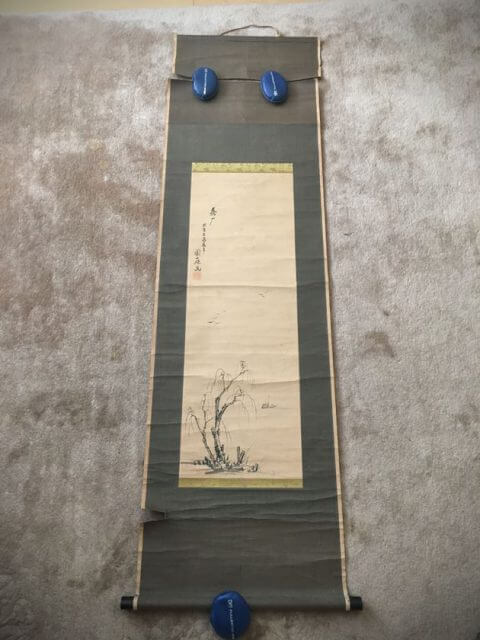
There was a note on the back of the scroll and we translated it from Japanese to English as below.
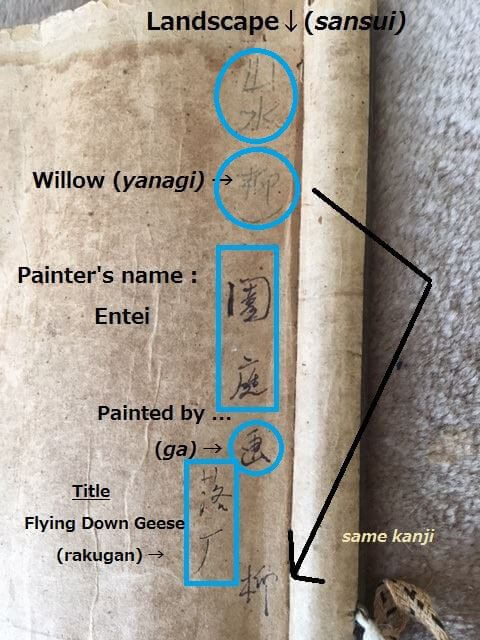
The subject of the painting is 落雁(rakugan). Rakugan means wild geese that are returning home in a line. It is a characteristic scenery of Lake Biwa in Shiga prefecture and can be seen at dusk during late-autumn to winter. The scenic view is known as “wild geese returning home at Katata(堅田の落雁)” and had been a popular subject for ukiyo-e artists such as Suzuki Harunobu and Utagawa Hiroshige. This subject is one of “The Eight Views of Ōmi (in Japanese: 近江八景 or Ōmi hakkei)” that are traditional scenic views of Ōmi Province which is now Shiga Prefecture in Japan.
The sights that were depicted by Hiroshige in several different series of ukiyo-e pictures are probably the most famous among all.
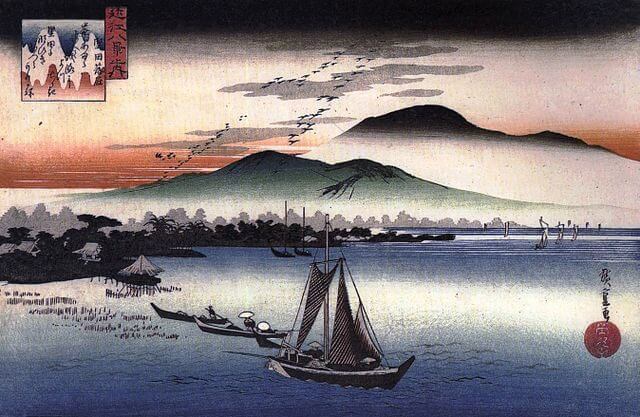
Wild geese returning home at Katata
Following the small note on the scroll, Tim-san requested us to inscribe a paulownia wooden box lid, so we talked about spacing and layout as below;
Title: 落雁
Date: 大正五丙辰年 =Year 1916(This was written on the honshi.)
Artist: 園庭画 (painted by Entei)
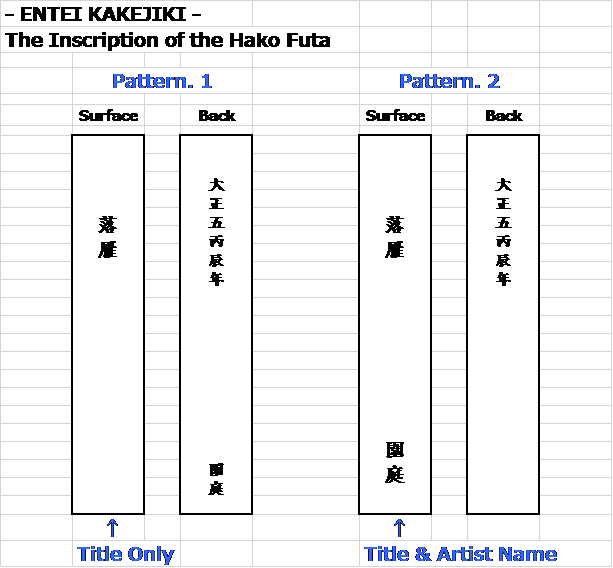
Tim-san’s choice is pattern# 2. It’s going to be fantastic in the end!
We first thought the Entei kakejiku was in a manner of Maru-mounting style. However, after receiving the Entei kakejiku here, we noticed that mount paper for ten-chi(top & bottom) and for naka-mawashi(inner enclosure) were different. This means the kakejiku was actually in Yamato mounting style WITHOUT fuutai(decorative strips), which is very rare. So we decided to go for Yamato, the same mounting style as the original.
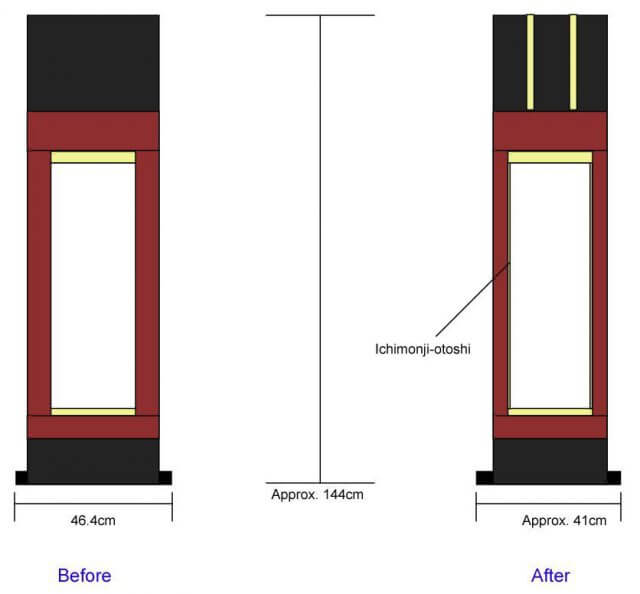
We suggested adding ichimon-ji otoshi for a more polished look with three different mount fabrics.
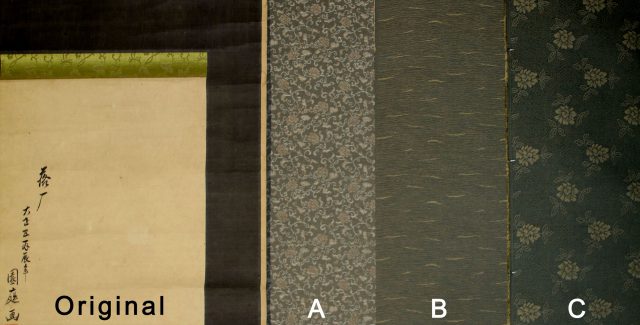
Zoom
- Original
- Pattern A
- Pattern B
- Pattern C
One thing to be careful of before starting remounting is that the creases under artist’s signature and around the top of the tree may be left since they are big and deep.
The decision Has Been Made!
Remounting of Entei kakejiku in Yamato mounting style in a manner of ichimon-ji oto-shi.
Mount fabric: A
Size: approx. 41(w)cm x 144(l)cm
A paulownia wooden box with the inscription of a box lid (hako-futa).
Ok, let’s begin!
Restration Process
Removing Old Backing Paper
You can clearly see multiple layers of backing paper.
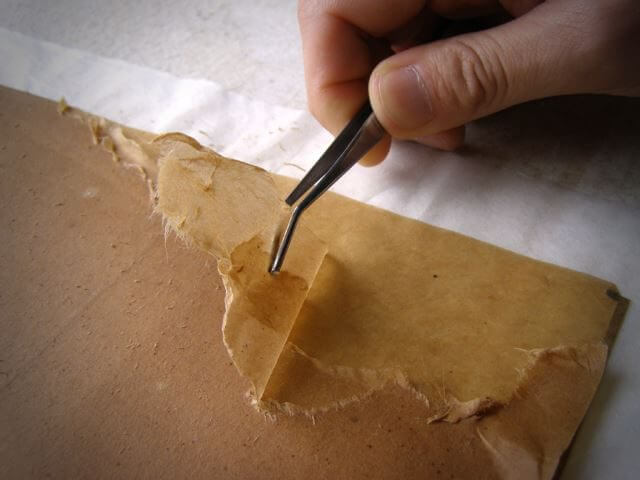
We remove paper residues of naka-mawashi(inner-enclosure) too.
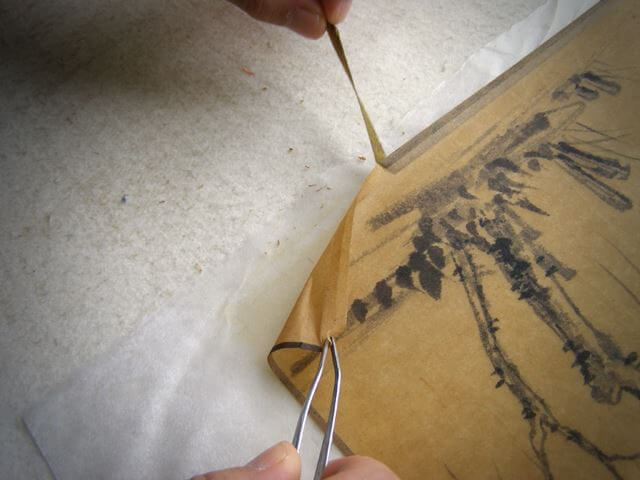
Backing
Wet enough the artwork and stretch it evenly, let’s start applying a new backing paper.
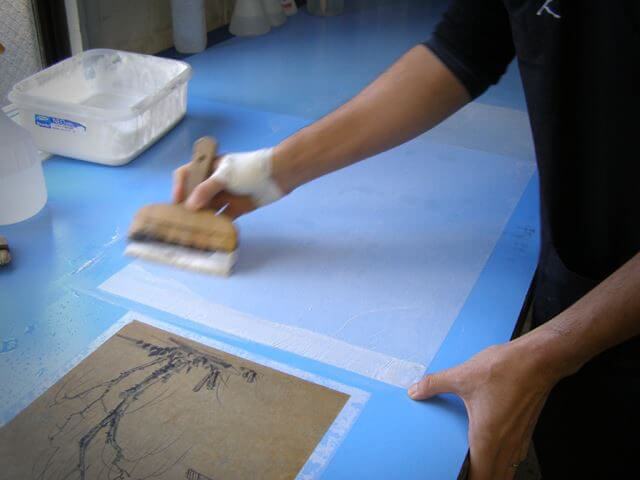
We are applying a pasted backing paper onto the artwork.
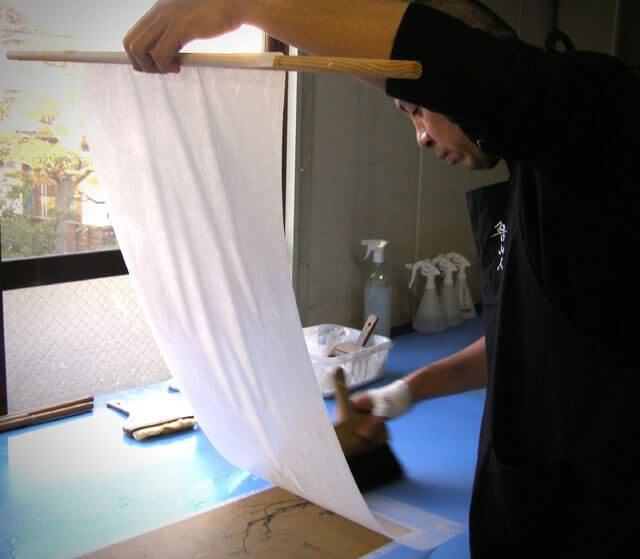
After attaching the backing paper, its surface is tapped with the brush for adhering the backing paper firmly to the main work. Keep tapping until they adhere to each other completely.
Once done, put it on a kari-bari- board to dry.
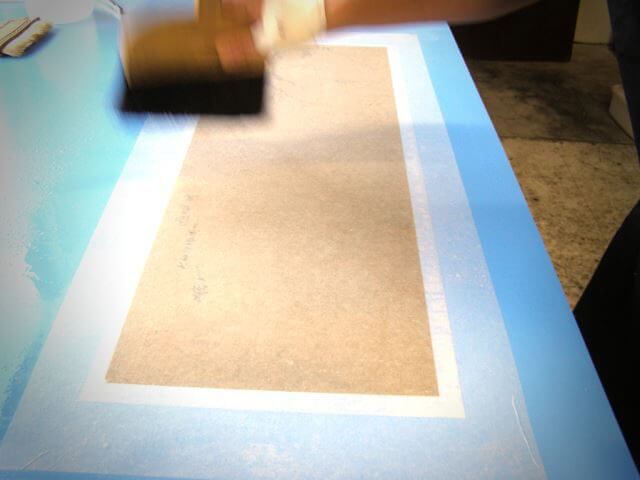
Cut-and-Join / Tsukemawashi
Now we cut the excess backing paper, making an accurate square (90 degrees) with a triangle.
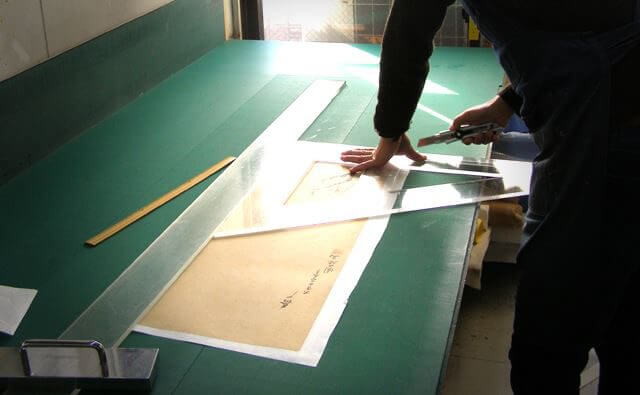
All the pieces of mount fabrics are ready. Let’s move on to tsuke-mawashi(applying mount fabrics).
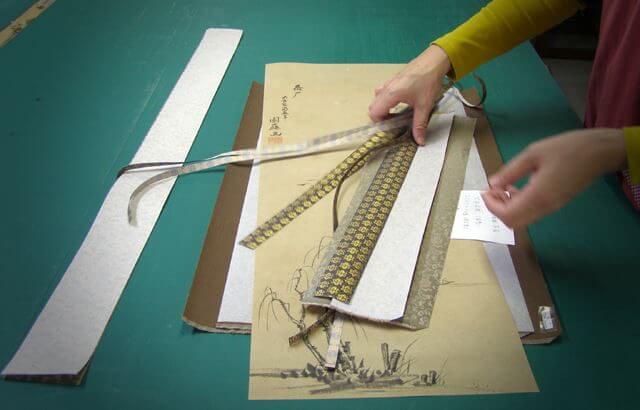
The picture is about preparing fabric sets that are to be applied at the end of tsuke-mawashi. The process is to combine the top (ten) and the upper naka-mawashi(inner enclosure), then the bottom (chi) and the lower naka-mawashi(inner enclosure). Our member devises a way to improve quality and to save time for the smooth finish.
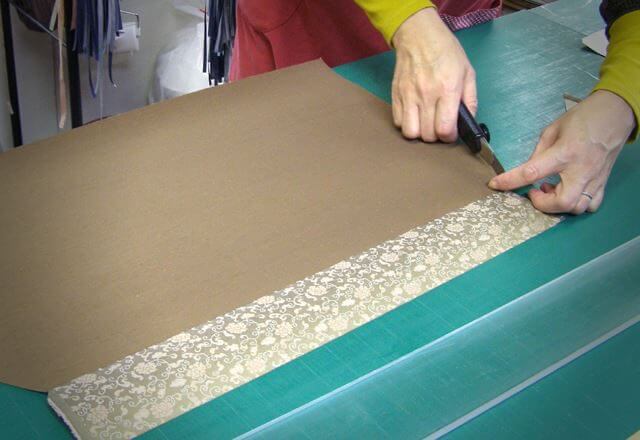
It is the back of the artwork. You can see ore-fuse in the middle. This has been done to reinforce a deep crease under the artist’s chop.
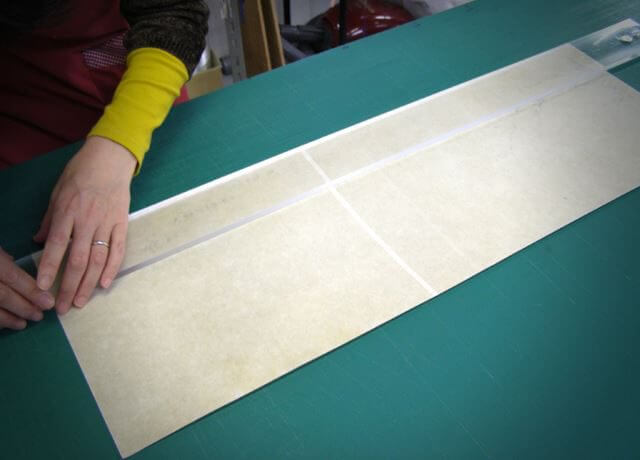
Ichi-monji-otoshi first, top & bottom ichi-monji second and naka-mawashi(inner enclosure) comes next. All that’s left now is to apply the combination we first prepared.
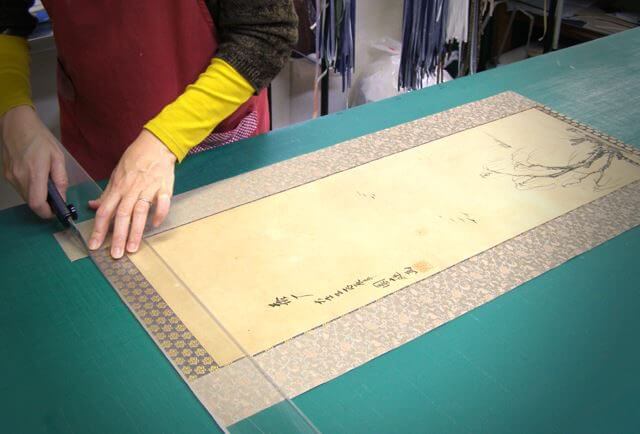
We are done with tsuke-mawashi!
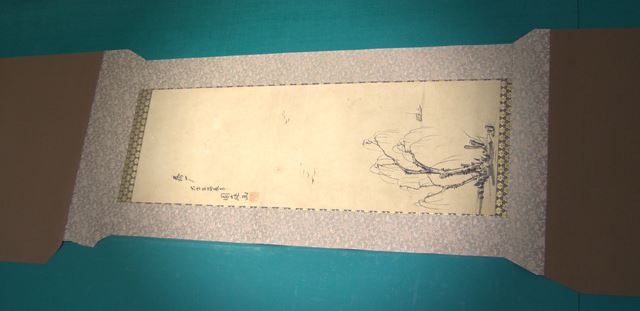
Mimi-ori / Folding over of the Edge
This is a mimi-ori procedure.
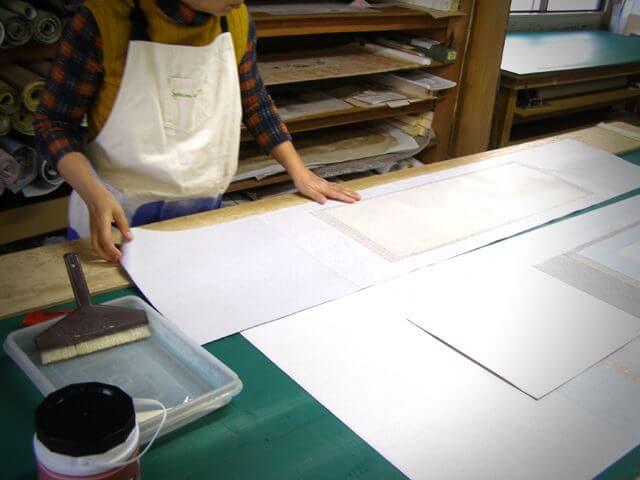
Finishing
We apply ring tacks, fuutai (decorative strips), kakeo (hanging cord), and lastly makio (wrapping cord) to a top hanging rod.
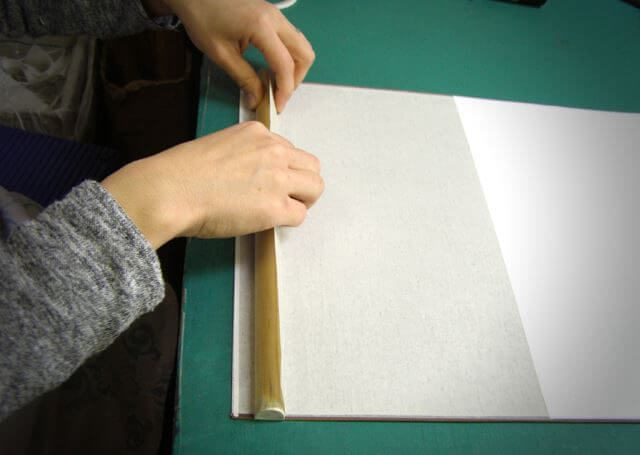
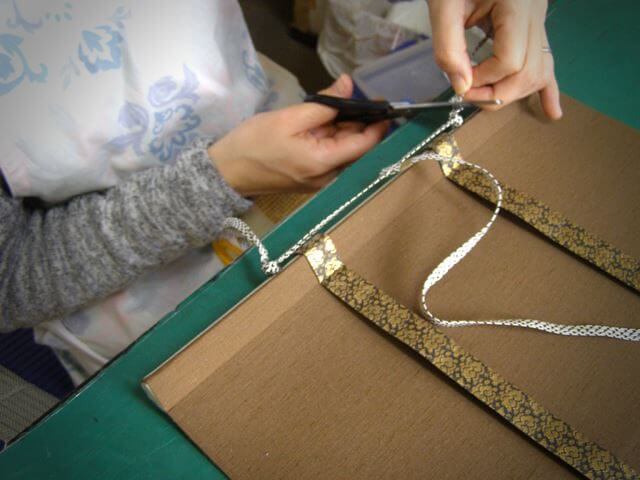
Applying a lower roller rod.
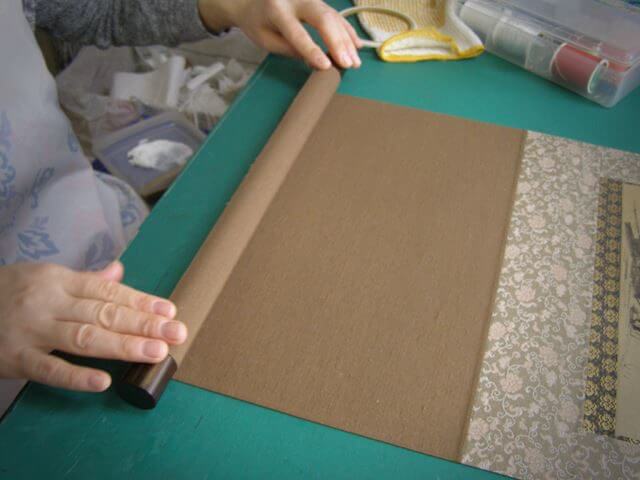
Now it’s complete!
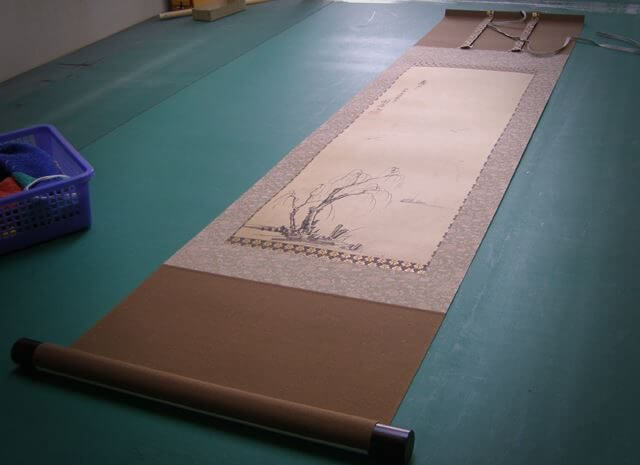
The deep crease around the top of the tree became unnoticeable.
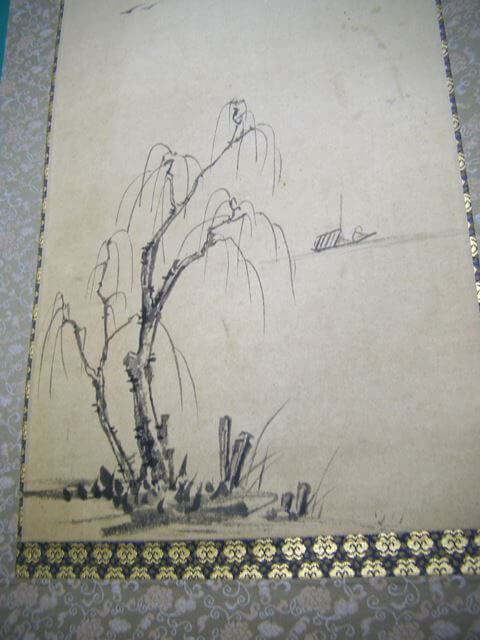
Inscription of the Hako Futa
Here is the inscription of the hako futa (box lid).
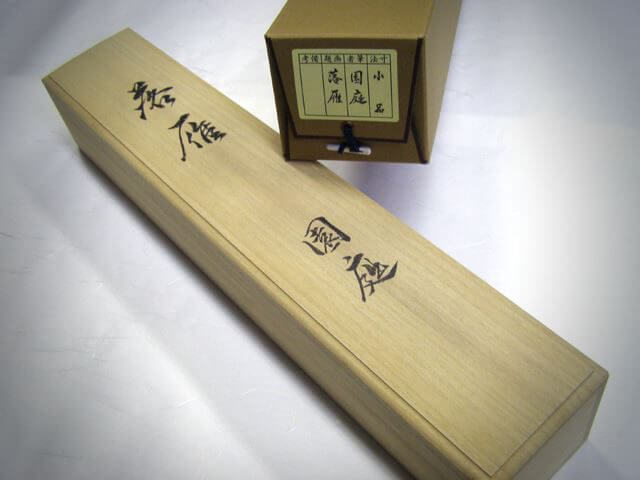
Inside the paulownia wooden box.
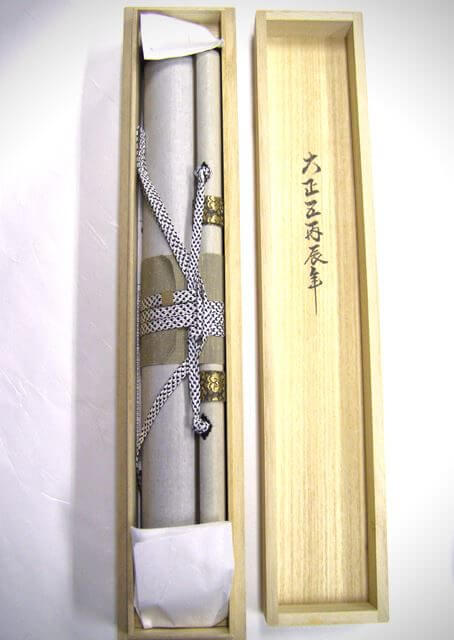
Before & After Restoration
The finished scroll looks modest and has a mature look.
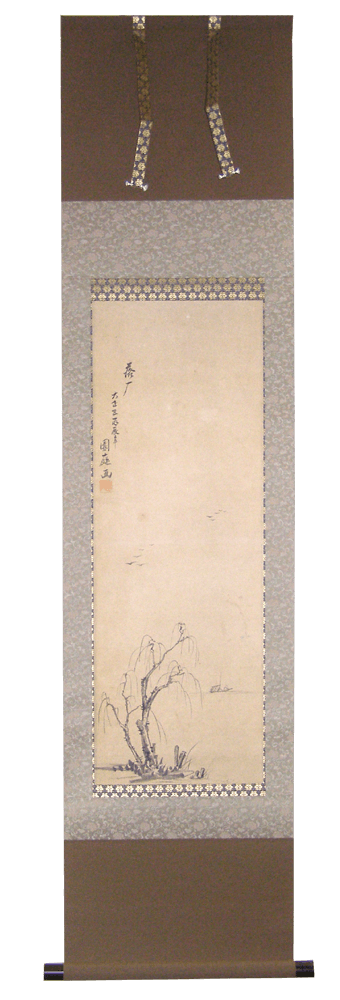
We are very happy to receive feedback from Tim-san as follows;
“Thank you for the wonderful restoration and mounting of these artworks!”
Thank you! It means really a lot to us. We feel happy when clients feel happy.
We look forward to working with you again in the future. Thank you very much for your order.
Video



